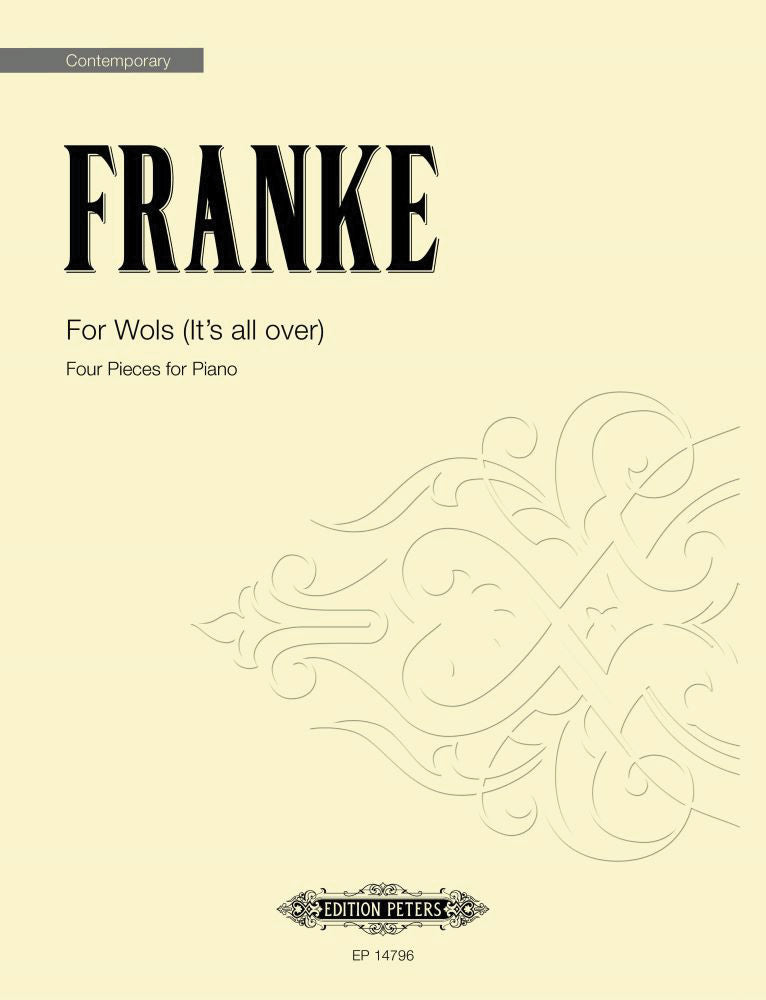Franke: For Wols
It's all over - Four Pieces for Piano
This item is made to order and typically ships within 1-2 weeks.
- Composer: Bernd Franke (1959-)
- Instrumentation: Piano
- Work: For Wols (It's all over)
- ISMN:
- Size: 9.1 x 11.8 inches
Description
"For Wols" was written in 1991 at the suggestion of the Cologne pianist Michael Graubner and commissioned by the Düsseldorf Tonhalle.
The premiere took place in Düsseldorf in 1993, and in 1994 "For Wols" was produced by Hessian Radio. "For Wols" was produced by Hessischer Rundfunk in 1994.
The dedication and subtitle of these four pieces for piano refer to the restless and tragic life as well as various works of the great German abstract painter Wols, who was born Wolfgang Schulze in Berlin in 1913, grew up in Dresden and died prematurely, aged just 38, completely impoverished in Paris.
Manfred H. Wenninger, excerpt from a portrait programme on Hessischer Rundfunk in 1996:
"‘For Wols (It's all over)' is an endgame. But it doesn't lead to a decision like in chess or football game; ‘endgame' would be better understood here in Beckett's sense, as an ‘old endgame that has always been lost'. Development takes place here, if at all, only in the smallest, often stuttering dimensions, tending to freeze into a point without development.
In the end, the ultimate opposition: two opposing voices in widely splayed positions. in an apparent contradiction of seeming static and violent outburst, the two inspiring starting points to which the title alludes are found: the paintings of the painter Wolfgang Schulze, whose abstract works Franke describes as partly filigree-silent, partly violently expressive; as well as Franke's thoughts and feelings during the Gulf War."
Publishers use a lot of words to describe what they sell, and we know it can be confusing. We've tried to be as clear as possible to make sure you get exactly what you are looking for. Below are descriptions of the terms that we use to describe the various formats that music often comes in.
Choral Score
A score for vocalists that only contains the vocal lines. The instrumental parts are not there for reference. Generally, cheaper than a vocal score and requires multiple copies for purchase.
Facsimile
Reproductions of the original hand-written scores from the composer.
Full Score
For ensemble music, this indicates that the edition contains all parts on a single system (there are not separate parts for each player). In larger ensembles, this is for the conductor.
Hardcover
Hardbound. Generally either linen-covered or half-leather.
Orchestral Parts
Similar to a wind set, this is a collection of parts. In the case of strings, the numbers listed are the number of copies included, though generally these are available individually (often with minimum quantities required).
Paperback
When publishers offer multiple bindings (e.g. hardcover) or study scores, this is the "standard" version. If you're planning to play the music, this is probably what you want.
Performance / Playing Score
A score of the music containing all parts on one system, intended for players to share. There are not separate parts for each player.
Set of Parts
For ensemble music, this indicates that there are separate individual parts for each player.
Solo Part with Piano Reduction
For solo pieces with orchestra, this is a version that contains a piano reduction of the orchestra parts. For piano pieces, two copies are typically needed for performance.
Study Score
A small (think choral size) copy of the complete score meant for studying, and not playing. They make great add-ons when learning concertos and small chamber works.
Vocal Score
A score prepared for vocalists that includes the piano/organ part or a reduction of the instrumental parts.
Wind Set
For orchestral music, this is a collection of wind and percussion parts. The specific quantities of each instrument are notated.
With Audio
In addition to the printed music, the edition contains recordings of the pieces. This may be an included CD, or access to files on the internet.
With / Without Fingering (Markings)
Some publishers prepare two copies - a pure Urtext edition that includes no fingering (or bowing) suggestions and a lightly edited version that includes a minimal number of editorial markings.



